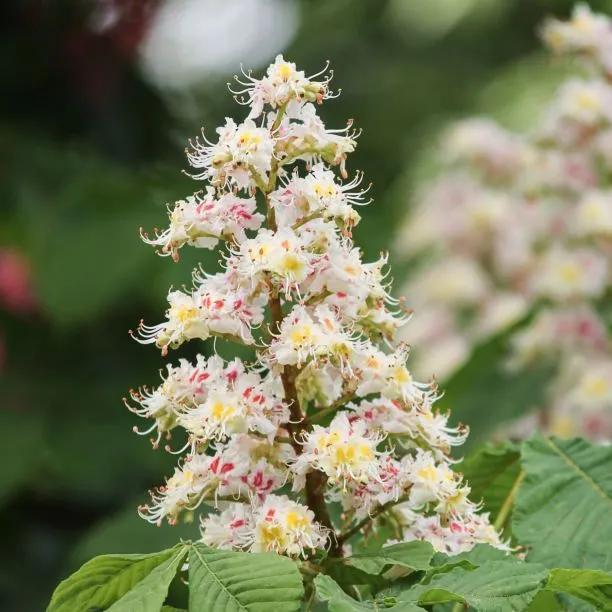White Horse Chestnut, Large Trees
The details
- Fast growing, spreading. Any soil.
- Thick white flower cones.
- No Conkers.
- Sizes: Standards only.
- Max. Height: 20m
- Bareroot Delivery: Nov-Mar.
Description
Aesculus hippocastanum Baumannii: Bareroot White Horse Chestnut Trees in Standard Sizes
The White Horse Chestnut, Aesculus hippocastanum Baumannii, has double flowers that are mostly white, with small pink dots in the centre. It is smaller than the Wild Horse Chestnut, so it's a better choice for a garden and has more ornamental value, because you can see more of the flowers from the ground.
It is a sterile tree, so you won't have any conkers to clear off pathways. This may be bad news for the kids, but it also means that this tree is safe to plant around livestock as Horse Chestnuts, despite the name, are poisonous to most animals.
They can reach a height of about 20-25 metres with a spread of 15 metres.
Browse our other varieties of Chestnut tree, our or complete list of trees.
Delivery season: White Horse Chestnut trees are delivered bareroot during late autumn and winter, approximately November-March inclusive.
Choosing a size: Small trees are cheaper, easier to handle and more forgiving of less than ideal aftercare, so they are best for a big planting project. If instant impact is your priority, or if you are only buying a few plants for use in a place where it is convenient to water them well in their first year, then you may as well use bigger ones. All our bareroot trees are measured by their height in centimetres above the ground (the roots aren't measured).
Features:
- Height: 20-25m
- Soil: Any well drained
- Use: Specimen, parkland, avenue, urban
- Colour: Mostly white, double flowers in May-June
- Safe for horses
- Bareroot delivery only: November-March
Growing Baumannii Chestnut Trees
Any well drained soil. Full sun is ideal, but it is fine to plant in partial shade where they will grow into the sun. Tolerant of pollution.
Planting Instructions
Notes on planting White Horse Chestnut trees:
Horse Chestnuts are big trees with powerful roots, we recommend planting them at least 30 metres away from buildings. They will grow in any soil and young trees tolerate shade well, although they will do their best to grow rapidly up into the sun. Mature trees will often be as wide as they are tall: this variety will reach about 20 metres.
Prepare your site before planting:
It is good to dig over the site where you plant a tree several months in advance. Kill the weeds first: for tough weeds like nettles, brambles and ground elder, you will usually need a weed-killer to get rid of them. When you dig the soil over, remove stones and other rubbish and mix in well rotted compost or manure down to the depth of about 2 spades.
Watch our video on how to plant a tree for full instructions.
Remember to water establishing trees during dry weather for at least a year after planting.
Tree Planting accessories:
Prepare your site for planting by killing the weeds and grass.
You can buy a tree planting pack with a wooden stake & rubber tie to support the tree and a mulch mat with pegs to protect the soil around the base of your tree from weeds and drying out.
We suggest that you use mycorrhizal "friendly fungi" on the roots of all newly planted large trees: if your soil quality is poor, we strongly recommend it.
You can also improve your soil with bonemeal organic fertiliser.
Did You Know?
Baumannii appeared as a natural mutation, called a sport, of the common chestnut around 1820, discovered by Constantin Auguste Napoleon Baumann (1804-1884), who would go on to be one of the managers of Baumann FrC(res plant nursery in Bollwiller, France (some records say that he discovered the sport on a tree near Geneva).
It is sometimes listed as Aesculus Flore Pleno.
Standard trees are measured by their girth in centimetres 1 metre above ground level: their trunk's waist measurement. Unlike sapling trees and hedge plants, standards aren't measured by their height, which will vary quite a bit both between and within species.
So, a 6/8cm standard tree has a trunk with a circumference of 6-8cm and an 8/10 standard has a trunk 8-10cm around. This measurement makes no difference to the tree's final height.
On average, standard trees are 2-3.5 metres tall when they arrive, but we cannot tell you precisely how tall your trees will be before we deliver them.


